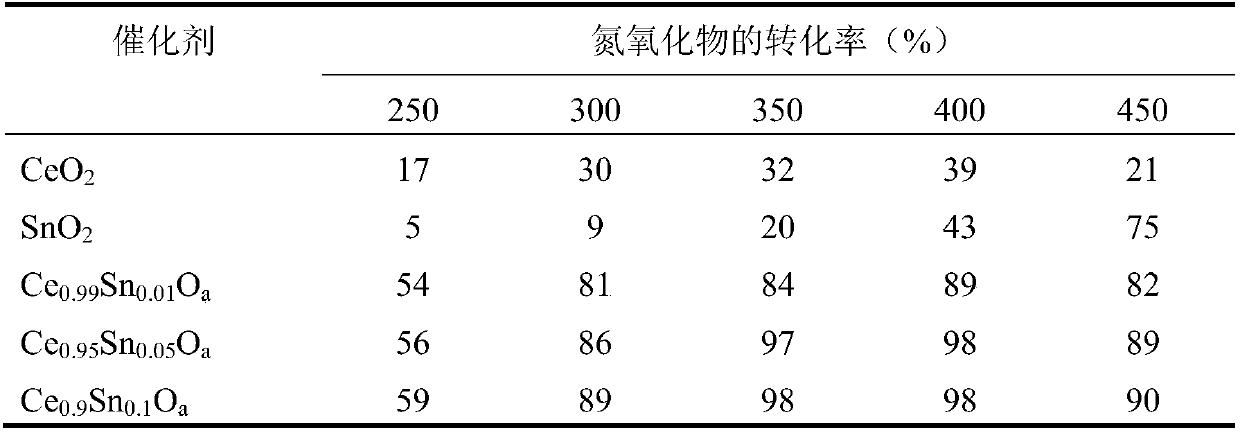Cerium-tin composite oxide denitration catalyst as well as preparation method and application thereof
A technology of composite oxides and catalysts, applied in the direction of metal/metal oxide/metal hydroxide catalysts, physical/chemical process catalysts, chemical instruments and methods, etc., can solve the problems of poor high temperature thermal stability, narrow temperature window, and easy sublimation and other problems, to achieve the effect of improving activity, strong synergistic catalytic effect, and improving water and sulfur resistance
- Summary
- Abstract
- Description
- Claims
- Application Information
AI Technical Summary
Problems solved by technology
Method used
Image
Examples
Embodiment 1
[0017] Example 1: Ce 0.99 sn 0.01 o a Preparation of composite oxide catalyst
[0018] a) Take 39.6ml of 0.50mol / L cerium acetate solution and 4ml of 0.05mol / L tin tetrachloride solution respectively, stir and mix in a water bath at 30°C for 60 minutes to obtain a mixed solution;
[0019] b) Add ammonia water to the mixed solution obtained in step a) under constant stirring until the pH value is 11, transfer the obtained mixed solution to a hydrothermal reaction kettle, perform a hydrothermal reaction at 150° C. for 12 hours, and then lower it to room temperature;
[0020] c) The reaction solution obtained in step b) was suction filtered, washed, dried at 120°C for 24 hours, and then calcined in a muffle furnace at 500°C for 4 hours to obtain Ce 0.99 sn 0.01 o a composite oxide catalyst.
Embodiment 2
[0021] Example 2: Ce 0.95 sn 0.05 o a Preparation of composite oxide catalyst
[0022] a) Take 19ml 1mol / L cerium nitrate solution, 10ml 0.1mol / L tin tetrachloride solution, 40℃ water
[0023] The bath was stirred and mixed for 60 minutes to obtain a mixed solution;
[0024] b) adding ammonia water to the mixed solution obtained in step a) under constant stirring until the pH value is 10, and the obtained mixed solution
[0025] Transfer to a hydrothermal reaction kettle, hydrothermally react at 120°C for 24 hours, and then drop to room temperature;
[0026] c) The reaction solution obtained in step b) is suction filtered, washed, dried at 120°C for 12 hours, and then calcined in a muffle furnace at 500°C for 8 hours to obtain Ce 0.95 sn 0.05 o a composite oxide catalyst.
Embodiment 3
[0027] Example 3: Ce 0.9 sn 0.1 o a Preparation of composite oxide catalyst
[0028] a) Take 18ml 1mol / L cerium nitrate solution, 20ml 0.1mol / L tin tetrachloride solution, 30℃ water
[0029] The bath was stirred and mixed for 60 minutes to obtain a mixed solution;
[0030] b) adding ammonia water to the mixed solution obtained in step a) under constant stirring until the pH value is 10, and the obtained mixed solution
[0031] Transfer to a hydrothermal reaction kettle, hydrothermally react at 120°C for 48 hours, and then drop to room temperature;
[0032] c) The reaction solution obtained in step b) was suction filtered, washed, dried at 120°C for 24 hours, and then calcined in a muffle furnace at 500°C for 6 hours to obtain Ce 0.9 sn 0.1 o a composite oxide catalyst.
PUM
 Login to View More
Login to View More Abstract
Description
Claims
Application Information
 Login to View More
Login to View More - R&D
- Intellectual Property
- Life Sciences
- Materials
- Tech Scout
- Unparalleled Data Quality
- Higher Quality Content
- 60% Fewer Hallucinations
Browse by: Latest US Patents, China's latest patents, Technical Efficacy Thesaurus, Application Domain, Technology Topic, Popular Technical Reports.
© 2025 PatSnap. All rights reserved.Legal|Privacy policy|Modern Slavery Act Transparency Statement|Sitemap|About US| Contact US: help@patsnap.com


